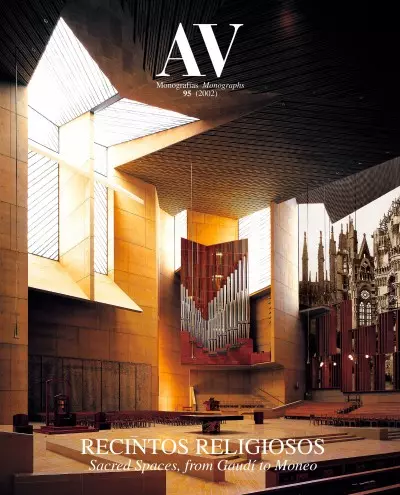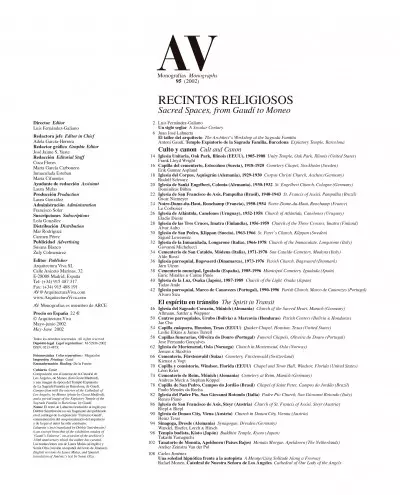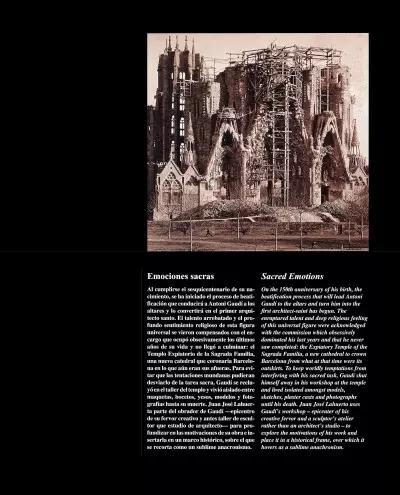RECINTOS RELIGIOSOS
Sacred Spaces, from Gaudí to MoneoLuis Fernández-Galiano
Un siglo seglar
A Secular Century
Juan José Lahuerta
El taller del arquitectoThe Architect’s Workshop at the Sagrada Familia
Antoni Gaudí, Templo Expiatorio de la Sagrada Familia, BarcelonaExpiatory Temple, Barcelona
Culto y canon
Cult and Canon
Iglesia Unitaria, Oak Park, Illinois (EEUU), 1905-1908 Unity Temple, Oak Park, Illinois (United States)
Frank Lloyd Wright
Capilla del cementerio, Estocolmo (Suecia), 1918-1920Cemetery Chapel, Stockholm (Sweden)
Erik Gunnar Asplund
Iglesia del Corpus, Aquisgrán (Alemania), 1929-1930Corpus Christi Church, Aachen (Germany)
Rudolf Schwarz
Iglesia de Sankt Engelbert, Colonia (Alemania), 1930-1932 St. Engelbert Church, Cologne (Germany)
Dominikus Böhm
Iglesia de San Francisco de Asís, Pampulha (Brasil), 1940-1943 St. Francis of Assisi, Pampulha (Brazil)
Óscar Niemeyer
Notre-Dame-du-Haut, Ronchamp (Francia), 1950-1954 Notre-Dame-du-Haut, Ronchamp (France)
Le Corbusier
Iglesia de Atlántida, Canelones (Uruguay), 1952-1958 Church of Atlántida, Canelones (Uruguay)
Eladio Dieste
Iglesia de las Tres Cruces, Imatra (Finlandia), 1956-1959 Church of the Three Crosses, Imatra (Finland)
Alvar Aalto
Iglesia de San Pedro, Klippan (Suecia), 1963-1966 St. Peter’s Church, Klippan (Sweden)
Sigurd Lewerentz
Iglesia de la Inmaculada, Longarone (Italia), 1966-1978 Church of the Immaculate, Longarone (Italy)
Giovanni Michelucci
Cementerio de San Cataldo, Módena (Italia), 1971-1978 San Cataldo Cemetery, Modena (Italy)
Aldo Rossi
Iglesia parroquial, Bagsvaerd (Dinamarca), 1973-1976 Parish Church, Bagsvaerd (Denmark)
Jørn Utzon
Cementerio muncipal, Igualada (España), 1985-1996 Municipal Cemetery, Igualada (Spain)
Enric Miralles & Carme Pinós
Iglesia de la Luz, Osaka (Japón), 1987-1989 Church of the Light, Osaka (Japan)
Tadao Ando
Iglesia parroquial, Marco de Canavezes (Portugal), 1990-1996 Parish Church, Marco de Canavezes (Portugal)
Álvaro Siza
El espíritu en tránsito
The Spirit in Transit
Iglesia del Sagrado Corazón, Múnich (Alemania) Church of the Sacred Heart, Munich (Germany)
Allmann, Sattler & Wappner
Centros parroquiales, Urubo (Bolivia) & Marcovia (Honduras) Parish Centers (Bolivia & Honduras)
Jae Cha
Capilla cuáquera, Houston, Texas (EEUU) Quaker Chapel, Houston, Texas (United States)
Leslie Elkins & James Turrell
Capillas funerarias, Oliveira do Douro (Portugal) Funeral Chapels, Oliveira do Douro (Portugal)
Jose Fernando Gonçalves
Iglesia de Mortensrud, Oslo (Noruega) Church in Mortensrud, Oslo (Norway)
Jensen & Skodvin
Cementerio, Fürstenwald (Suiza) Cemetery, Fürstenwald (Switzerland)
Kienast & Vogt
Capilla y consistorio, Windsor, Florida (EEUU) Chapel and Town Hall, Windsor, Florida (United States)
Léon Krier
Cementerio de Reim, Múnich (Alemania) Cemetery at Reim, Munich (Germany)
Andreas Meck & Stephan Köppel
Capilla de San Pedro, Campos do Jordão (Brasil) Chapel of Saint Peter, Campos do Jordão (Brazil)
Paulo Mendes da Rocha
Iglesia del Padre Pío, San Giovanni Rotondo (Italia) Padre Pio Church, San Giovanni Rotondo (Italy)
Renzo Piano
Iglesia de San Francisco de Asís, Steyr (Austria) Church of St. Francis of Assisi, Steyr (Austria)
Riepl & Riepl
Iglesia de Donau City, Viena (Austria) Church in Donau City, Vienna (Austria)
Heinz Tesar
Sinagoga, Dresde (Alemania) Synagogue, Dresden (Germany)
Wandel, Hoefer, Lorch & Hirsch
Templo budista, Kioto (Japón) Buddhist Temple, Kyoto (Japan)
Takashi Yamaguchi
Tanatorio de Monuta, Apeldoorn (Países Bajos) Monuta Morgue, Apeldoorn (The Netherlands)
Atelier Zeinstra Van der Pol
Carlos Jiménez
Una soledad hipnótica frente a la autopista A Mesmerizing Solitude Along a Freeway
Rafael Moneo, Catedral de Nuestra Señora de Los Ángeles Cathedral of Our Lady of the Angels
Luis Fernández-Galiano
A Secular Century
The past was a secular century. The etymological redundancy refers not only to the decline of the sacred in the 20th century; it also underscores its exacerbated temporality. If we live in the century we know ourselves to be outside religious grounds, and thereby cast into the torrential flow of the contemporary. Secular or lay, and therefore redeemed from the twin tutelage of faith and metaphysics, the survivors of this murderous century have learned to accept the disenchantment of the world and the death of God. Dwelling in space as Greeks and existing in time as Hebrews, we have built a technical civilization that has urbanized the planet and provided the means to de-urbanize it. With this victory and defeat of the spirit, the mutation of churches into identity traits of geographic or ethnic communities has reduced religion to a weapon of the civilizations clash – as the recomposition of the atlas of the empire is called in these skeptical and cynical times – and worship to a tradition of the lower classes.
Between the withdrawn piety of the Gaudí secluded in his workshop at Barcelona’s Sagrada Familia and the cosmopolitan agnosticism of the Moneo who builds the concrete folds of the Los Angeles Cathedral there is a century of sacred spaces better described by the history of architecture than by the history of religions, and fed with spiritual energy more for their connection to an aesthetic doctrine than for their fitting a liturgical choreography. Christian mostly – since it is within this cultural sphere where secular modernity emerged – these temples and cemeteries compose a landscape of reluctant fragments that contradict the militant atheism of some avant-gardes, but also confirm the crisis of religious faith. From Nordic romanticism to southern classicism, and from the laconicism of ascetics to the loquacity of preachers, the forms of cult in the past century turned into a cult of forms, celebrating the rite without ritual of artistic truth.
In its last stretch, religious architecture explodes in heteroclite splinters that extend from the colossal churches provided for the spectacle of the masses to the anonymous multi-denominational chapels of airports, from signature construction to amateur theology, and from artistic installations to minimalist landscapes. Imago mundi of a secular world, divine body of a skeptical god, and mystical precinct of a trivial mystery, this sacred architecture believes only in the deliberate worship of space, in the meticulous discipline of matter and in the demanding religion of detail. Exquisite and perhaps dispensable, its episodic works present themselves as sanctuaries of their own perfection; but the violent quiver of faith already lives in other tabernacles, in the Koranic madrasas of unanimous mosques or in the political pedagogy of holocaust museums. Inhabitants of a lay continent, neighbors of Islamic theocracies and subject to transatlantic Christian fundamentalism, Europeans enter the 21st century without knowing if the spirituality claimed for it by Malraux will be finally luminous or homicidal.








